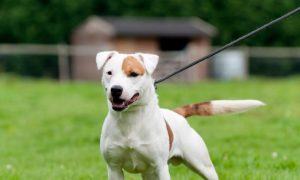“This post contains affiliate links, and I will be compensated if you make a purchase after clicking on my links.”
While it would be great to live in a world where dogs could run freely, aside from our own backyards and the local dog parks, it’s typically not allowed or not safe. (Plus, some of us have pets that are a tad too independent and don’t always stay close without a leash…) That said, dogs aren’t always thrilled to be leashed – some dogs downright hate it, they might pull you down the street or just plant their bottoms on the ground and not budge. But, the great folks at Pet Airways created this fantastic blog post for teaching your dog to walk on a leash.
Training Tips: Teaching Your Dog To Walk On A Leash
Start by teaching your dog to sit calmly while you put the leash on and to wait at the door until you open it and give a signal for him to follow you out. These safety measures ensure that he doesn’t knock you over or drag you out the door. Give the sit command and wait until he complies before attaching the leash. Then say “Stay” or “Wait” as you open the door. If he tries to get up or go out the door, start over. It may take a few minutes before you’re actually able to leave the house, but it’s a good foundation for nice walking on leash. Practice this every time, and soon it will become second nature to your dog.
When you start walking, you want your dog at your side. He doesn’t have to be in a formal “heel” position, but he shouldn’t be pulling on the leash or swerving in front of you, causing you to trip. Hold the leash in your left hand. Gather it close so there’s not a lot of slack.
They say that a journey of a thousand miles begins with a single step, and the same is true of leash training. Take a step forward and say “Let’s go” or whatever other phrase you choose. As long as your dog is by your side or out at the end of the leash but not pulling, you’re in good shape. The instant there is tension on the leash, stop! When your dog looks back at you or moves toward you so that the lead is slack, praise him and start walking again.
Continue stopping dead in your tracks every time your dog pulls on the leash or walks in front of you. Don’t move until he’s paying attention to you and back at your side. This can make for a really slow walk, but if you are consistent, your dog will quickly learn that the only way to get anywhere is to walk without pulling.
Another way to teach him that pulling is counterproductive is to turn around and go in the opposite direction. As long as the lead is slack, your dog can choose the route, but the instant he pulls, make a U-turn and go the other way. This is a good way for your dog to learn to keep his eyes on you so that he’ll always know which way you want to go. When he’s back at your side, praise him.
To teach directions, say “Left” every time you turn that way. Your dog will soon associate the word with the direction. You can do the same with “Right” or “Straight.” Other terms your dog should know on a walk are “On By” or “Leave It,” both meaning “Get away from that chicken bone or pile of vomit or dead snake and come back to me.”
Practice indoors and outdoors. Walk in different patterns—backward, forward, figure-8, zig-zag—so your dog will be prepared for any change in direction. Talk to him while you walk so his attention stays on you. The goal is to make leash-walking fun, so use your happy voice and give lots of praise. Even when he’s not on leash, praise him for following you, looking at you, or paying attention to the sound of his name.
Once you’re happy with his progress, introduce distractions to test the strength of your dog’s attention to you. Ask a friend or neighbor to walk toward you so he can practice approaching politely instead of pulling wildly. When he’s good at this, add new distractions, such as children or strangers. Whatever the enticement, he should approach without pulling.
Remember to keep the leash loose. Don’t use it to guide your dog in a particular direction. That will only encourage your dog to pull against the leash. Use your voice or hand signals to show him where to go.
Be patient and have fun! Even if you don’t get very far at first, end walks when your dog has done well. You want him to have a good time when he’s walking on leash, especially with you. Instead of trying to go for one long walk, take lots of short walks each day, increasing the distance as he improves.
With just a little practice and a LOT of patience, you’ll have no trouble at all teaching your dog to walk on a leash. Imagine how relaxing your walk around the block will be with your dog by your side, not fighting you every step of the way! Read more great tips from Pet Airways here. And, share your own stories of your leash walker below!


















